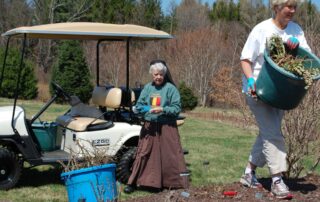 Pillar: Sacramental Ecology
Pillar: Sacramental Ecology
Laudato Si’ Action Plan Goals: Response to the Cry of the Earth
 Pillar: Sacramental Ecology
Pillar: Sacramental Ecology
Laudato Si’ Action Plan Goals: Response to the Cry of the Earth
Group (Grade Levels): Variable
Learning Goals:
- Go through the process of restoring order and beauty to a natural space.
- Learn patience and listening to creation through using elemental techniques.
Materials Needed: an area that needs to be restored/cleaned up; hand/low-tech tools appropriate for the work and safety, e.g., clippers, loppers, shovels, Tecnu in case of poison ivy exposure, bug spray; safety glasses; wheelbarrows; work gloves; water and snacks
Estimated Time to Complete Activity: time for introduction; one-to-three-hour work period; time for integration afterward
Estimated Number of Sessions if Activity Continues: until project is completed
Pre-planning:
- Identify and become familiar with the space and what is needed, prepare explanation of the need/the work, gather tools, consider safety concerns, identify realistic goals depending on group’s ability.
- Consider dividing up the work of restoration into phases and evaluate after each session. Initial work period is usually some form of clean up; this will organically open up possibilities for future development. (See “Opening Activity” Laudato Si’ )
- Create groups if needed.
- Create slips of paper with Laudato Si’ phrases to give to participants, or have them ready at hand to tell participants verbally.
- serene attentiveness; cry of the earth; book of nature; culture of care; throwaway culture; technocratic paradigm; reading reality in a Trinitarian key
General Outline of Experience
- Begin with experience from the life of St. Francis. Tell or read the San Damiano story from St. Francis’ biographer, Thomas of Celano:
- “With his heart already completely changed—soon his body was also to be changed—he was walking one day by the church of San Damiano, which was abandoned by everyone and almost in ruins. Led by the Spirit he went in to pray and knelt down devoutly before the crucifix. He was shaken by unusual experiences and discovered that he was different from when he had entered. As soon as he had this feeling, there occurred something unheard of in previous ages: with the lips of the painting, the image of Christ crucified spoke to him. ‘Francis,’ it said, calling him by name, ‘go rebuild My house; as you see, it is all being destroyed.’
Francis was more than a little stunned, trembling, and stuttering like a man out of his senses. He prepared himself to obey and pulled himself together to carry out the command. He felt this mysterious change in himself, but he could not describe it. So it is better for us to remain silent about it too. From that time on, compassion for the Crucified was impressed into his holy soul. And we honestly believe the wounds of the sacred Passion were impressed deep in his heart, though not yet on his flesh” (Second Life, #10, Francis of Assisi: Early Documents, Volume 2: The Founder, New City Press, p. 249).
- “With his heart already completely changed—soon his body was also to be changed—he was walking one day by the church of San Damiano, which was abandoned by everyone and almost in ruins. Led by the Spirit he went in to pray and knelt down devoutly before the crucifix. He was shaken by unusual experiences and discovered that he was different from when he had entered. As soon as he had this feeling, there occurred something unheard of in previous ages: with the lips of the painting, the image of Christ crucified spoke to him. ‘Francis,’ it said, calling him by name, ‘go rebuild My house; as you see, it is all being destroyed.’
- Make connection with the specific work you are going to do, making reference to the specific place and its needs.
- Like the Church and individual churches, creation is also God’s home, and when it is misused, the situation causes God pain. In little or sometimes great ways, we can “re-build” or restore creation. If it is a little plot of land, it is also significant, because it is God’s home.
- Point out how others joined Francis in the restoration work. We need one another to make the restoration happen.
- Lead the group in a prayer. Some options:
- Pray the Lord’s Prayer. Ask the group to be especially conscious when we pray “they kingdom come, they will be done, on earth as it is in heaven,” that we are responsible for re-building God’s kingdom (or “garden”) on earth.
- Lead a spontaneous prayer asking God to bless today’s efforts to restore the piece of land that it may more fully reveal God’s glory.
Demonstration of how to use tools:
- Introduce tools, recognizing sensitivity of those who do not know how to use them.
- Emphasize safety considerations and how to be aware of working around others.
- Send them out with a Laudato Si’ phrase that highlights the difference between listening to the land and imposing on the land. Some possibilities: serene attentiveness; cry of the earth; book of nature; culture of care; throwaway culture; technocratic paradigm; reading reality in a Trinitarian key.
- Participants work on the land according to instructions given. Have them work in groups and be specific about which area each group is assigned to.
- Proposed discussion questions during the activity:
- Be sensitive to potential analogies during the work.
- Encourage sense awareness, especially using senses we do not normally think of.
- Keep in mind the question of what within us needs to be restored. What is this process bringing to light?
Proposed discussion questions after re-grouping and enjoying a snack:
- What interesting or surprising creatures or aspects of nature did you observe?
- Follow up with discussion on the sacramental nature of creation. Each aspect of creation has something to communicate to us about who God is. Refer to Laudato Si’, n. 69 on the message of each creature:
- “Together with our obligation to use the earth’s goods responsibly, we are called to recognize that other living beings have a value of their own in God’s eyes: ‘by their mere existence they bless him and give him glory’, and indeed, ‘the Lord rejoices in all his works’ (Ps 104:31). By virtue of our unique dignity and our gift of intelligence, we are called to respect creation and its inherent laws, for ‘the Lord by wisdom founded the earth’ (Prov. 3:19). . . The Church does not simply state that other creatures are completely subordinated to the good of human beings, as if they have no worth in themselves and can be treated as we wish. . . The Catechism clearly and forcefully criticizes a distorted anthropocentrism: ‘Each creature possesses its own particular goodness and perfection. . . Each of the various creatures, willed in its own being, reflects in its own way a ray of God’s infinite wisdom and goodness.’”
- Reflect on the idea that the process and the end goal are both important and that in the process of restoring nature, something inside ourselves is also restored.
- How did this concrete work compare with your work online?
- Where else could you do this process of restoration?
Cross-references to related experiential activities: Cemetery Experience, Community Building, Little Portion, Mulching




